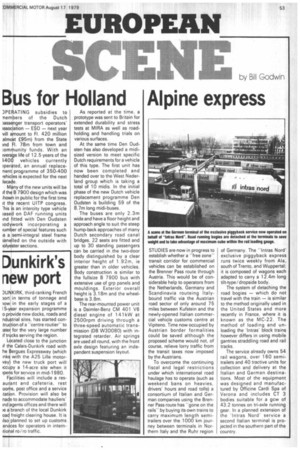Alpine express
Page 55

If you've noticed an error in this article please click here to report it so we can fix it.
STUDIES are now in progress to establish whether a "free zone" transit corridor for commercial vehicles can be established on the Brenner Pass route through Austria. This would be of considerable help to operators from the Netherlands, Germany and Scandinavia routeing Italybound traffic via the Austrian road sector of only around 75 miles between Kufstein and the newly-opened Italian commercial vehicle customs centre at Vipiteno. Time now occupied by Austrian border formalities could be saved although the proposed scheme would not, of course, relieve lorry traffic from the transit taxes now imposed by the Austrians.
To overcome the continuing fiscal and legal restrictions under which international road haulage has to operate (such as weekend bans on heavies, drivers' hours and road tolls) a consortium of Italian and German companies using the Brenner Pass route has "gone on the rails" by buying its own trains to carry maximum length semitrailers over the 1000 km journey between terminals in Northern Italy and the Ruhr region of Germany. The "Intras Nord' exclusive piggyback express runs twice weekly from Ala, south of Trento, and Wuppertal; it is composed of wagons each adapted to carry a 12.4m long tilt-type/ dropside body.
The system of detaching the road bogies — which do not travel with the train — is similar to the method originally used in the United States and more recently in France, where it is known as the MC-22. The method of loading and unloading the 'Intras' block trains however differs in using mobile gantries straddling road and rail tracks.
The service already owns 54 rail wagons, over 160 semitrailers and 40 tractive units for collection and delivery at the Italian and German destinations. Most of the equipment was designed and manufactured by Officine Cardi Spa of Verona and includes CT 3 bodies suitable for a gcw of 43.2 tonnes on tri-axle running gear. In a planned extension of the 'Intras Nord' service a second Italian terminal is projected in the southern part of the country.








































































































